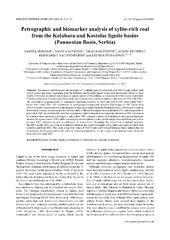| dc.creator | Đoković, Nataša | |
| dc.creator | Mitrović, Danica D. | |
| dc.creator | Životić, Dragana R. | |
| dc.creator | Bechtel, Achim | |
| dc.creator | Sachsenhofer, Reinhard F. | |
| dc.creator | Stojanović, Ksenija A. | |
| dc.date.accessioned | 2018-11-22T00:43:04Z | |
| dc.date.available | 2018-11-22T00:43:04Z | |
| dc.date.issued | 2018 | |
| dc.identifier.issn | 1335-0552 | |
| dc.identifier.uri | https://cherry.chem.bg.ac.rs/handle/123456789/2077 | |
| dc.description.abstract | The maceral and biomarker characteristics of 4 sublithotypes of xylite-rich coal (SXCs), pale yellow, dark yellow, brown and black, originating from the Kolubara and Kostolac lignite basins were determined. Based on these results, differences in sources and changes of organic matter (OM) resulting in formation of 4 SXCs were established. Conifers (particularly Cupressaceae, Taxodiaceae and Pinacea) had a significant impact on the precursor OM of all SXCs. The contribution of gymnosperm vs. angiosperm vegetation decreased in order pale yellow SXC gt dark yellow SXC gt brown SXC gt black SXC. The distribution of non-hopanoid triterpenoids indicates that change of SXC colour from -yellow to black is associated with reduced input of angiosperm plants from the Betulacea family. Differences in hopane distribution, bitumen content, proportion of short-chain n-alkanes and degree of aromatization of di-and triterpenoids of pale yellow SXC are controlled by microbial communities which took part in the diagenetic alteration of OM. The content of total huminites increased from black to pale yellow SXC, whereas contents of total liptinite and inertinite macerals showed the opposite trend. SXCs differ according to textinite/ulminite ratio, which sharply decreased from pale yellow to black SXC, reflecting increase in gelification of woody tissue. Regarding the composition of liptinite macerals, the SXCs mostly differ according to resinite/liptodetrinite and resinite/suberinite ratios, which are higher in yellow than in brown and black SXC. This result along with values of TOC/N ratio and Carbon Preference Index indicate that the contribution of well preserved woody material, including lignin tissue vs. the impact of epicuticular waxes decreased from yellow to black SXC. | en |
| dc.publisher | Slovak Acad Sciences Geological Inst, Bratislava | |
| dc.relation | info:eu-repo/grantAgreement/MESTD/Basic Research (BR or ON)/176006/RS// | |
| dc.relation | Osterreichischer Austauschdienst (OeAD) [SRB 18/2016] | |
| dc.rights | openAccess | |
| dc.rights.uri | https://creativecommons.org/licenses/by-nc-nd/4.0/ | |
| dc.source | Geologica Carpathica | |
| dc.subject | Kolubara | en |
| dc.subject | Kostolac | en |
| dc.subject | lignite | en |
| dc.subject | sublithotypes of xylite-rich coal | en |
| dc.subject | macerals | en |
| dc.subject | biomarkers | en |
| dc.title | Petrographic and biomarker analysis of xylite-rich coal from the Kolubara and Kostolac lignite basins (Pannonian Basin, Serbia) | en |
| dc.type | article | |
| dc.rights.license | BY-NC-ND | |
| dcterms.abstract | Стојановић, Ксенија; Ђоковић, Наташа; Сацхсенхофер, Реинхард Ф.; Бецхтел, Aцхим; Митровић, Даница; Зивотиц, Драгана; | |
| dc.citation.volume | 69 | |
| dc.citation.issue | 1 | |
| dc.citation.spage | 51 | |
| dc.citation.epage | 70 | |
| dc.identifier.wos | 000423855000004 | |
| dc.identifier.doi | 10.1515/geoca-2018-0004 | |
| dc.citation.other | 69(1): 51-70 | |
| dc.citation.rank | M23 | |
| dc.type.version | publishedVersion | |
| dc.identifier.scopus | 2-s2.0-85041955801 | |
| dc.identifier.fulltext | https://cherry.chem.bg.ac.rs/bitstream/id/9096/2075.pdf | |


